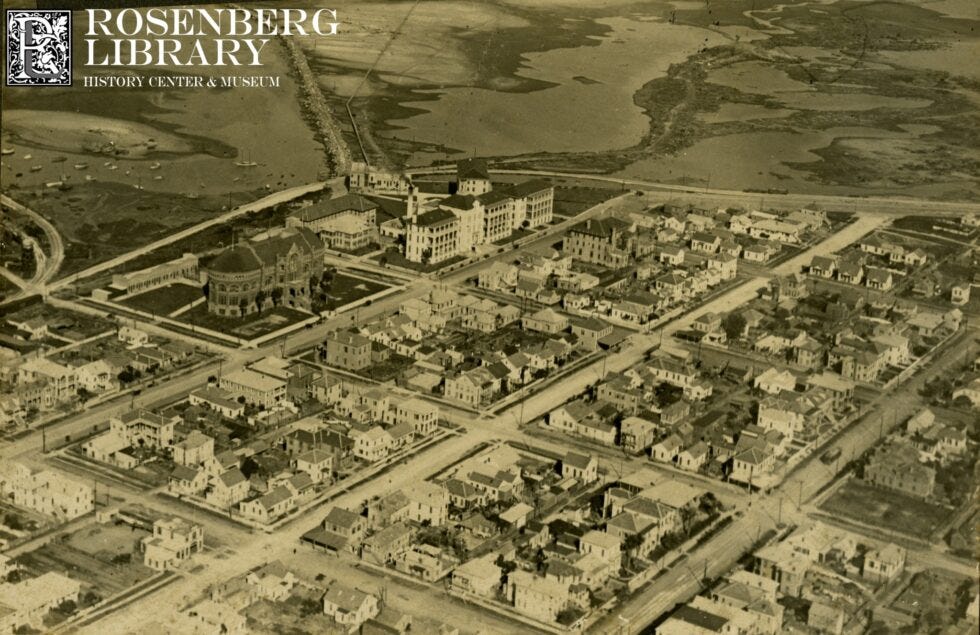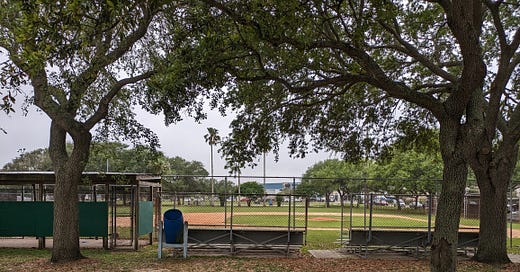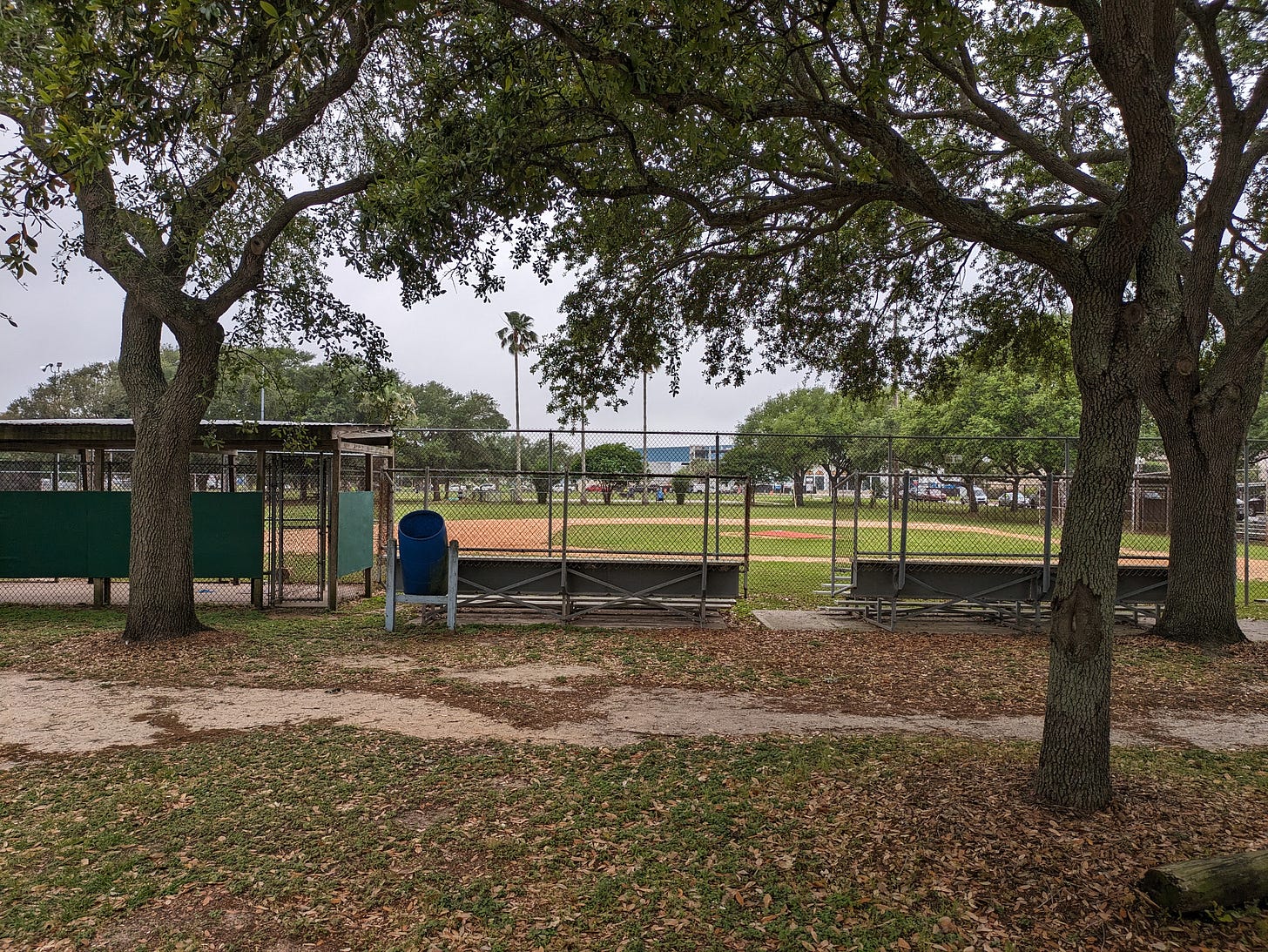The Last Karankawas: A place-centric book review
Fish Village gets its due – in a work of fiction
My subject is Galveston, and the subject of Kimberly Garza’s debut novel,1 The Last Karankawas, isn’t. Garza’s main subjects are a dozen immigrants or children of immigrants from the Philippines and Mexico who live in Galveston’s Fish Village and make up a polyglot2 community within the city’s larger one.
But the book would be a different animal if it took place elsewhere, which is the first part of my rationale for a Galveston-centric review.
Part 2: Other than real estate agents, who has written more than two paragraphs about Fish Village? I searched the Galveston and Texas History Center website and found nothing. I did find several links to its antecedents, Lindale Park (now an actual park) and the infamous East End Flats. I’ll have more to say about the fascinating prehistory of Fish Village later.
Part 3 and the clincher: The Last Karankawas is the best work of Galveston-centric fiction I’ve read.
But first, the gist.
The gist
The Last Karankawas is told from or about the perspectives of 12 characters through a series of self-contained stories. Many of them were originally published as self-contained short stories, but all are linked by each character’s relationship to another character, and to Galveston.
Three of the stories are narrated by the characters themselves. The rest have the benefit of an omniscient narrator who articulates their generally unexpressed judgments and feelings better than the characters could themselves.
The central figure is Carly Castillo, a child of Filipina and Mexican descent. We meet her in 1990 when she’s six years old, with her mother at Sacred Heart Catholic Church, a year after her father has abandoned them both and two months before her mother will abandon her. We see Carly next in 2008, shortly before Hurricane Ike strikes Galveston.
The storm becomes a central character in the second half of the book. Carly and her friends and family must decide whether to stay or evacuate. This decision – remaining vs. leaving – comes up in other contexts: relationships, family, community.
The stories take each character through Ike’s approach, the fraught skirmishes over whether to ride out the storm or leave, and the slow recovery afterward.
The book’s title comes from Carly’s paternal grandmother’s belief that they are descended from the Karankawa tribe, the original inhabitants of Galveston island. In the last chapter, it’s suggested that the grandmother likes to think they are related to the Karankawa because it would mean Galveston really is their home.
And that last chapter is altogether different from the rest. In “Galveston: A Glossary & Guide for the Uninitiated Traveller,” Garza adopts the tone of a whimsical scholar, providing mostly factual but occasionally fanciful descriptions of terms, notable people, and points of interest. Which brings us to…
Galveston in the novel
In its heyday, Galveston was known as the Ellis Island of the West. Just as New York City became home for many of those who entered America at Ellis, Galveston became home for thousands who arrived at its port. The city’s limited size persuaded most to continue north, but many stayed.
A century later, it’s more likely that documented immigrants will fly into Houston’s George Bush Intercontinental Airport, or that documented and undocumented immigrants will take a bus from the Rio Grande Valley or Central America. Galveston’s University of Texas Medical Branch and the city’s fishing and tourism industries are strong magnets.
Immigrants have always faced unique challenges. How can they respect their native cultures – their parents’ cultures – without alienating themselves from their new neighbors? How can they earn the right of belonging in this new place? And how much of this belonging is in their power to earn?
Finding their places in a new culture oversimplifies what Garza’s characters struggle with. Though they live in the same neighborhood, become friends, even fall in love, the Filipino and Mexican communities differ from each other, and these internecine tensions alternately simmer and boil.
Like the actual one, Garza’s Galveston is crowded with visitors, Americans usually, coming here for a week or a weekend. For most Americans, Galveston is a diversion. For immigrants, it’s a home. They have a far stronger stake in the city than American tourists.
Fish Village
The rush-hour traffic on Broadway, the main artery connecting the island to the mainland, is much heavier at 5pm than at 8am. At 5pm, folks are heading home. A great many of those who work in Galveston live on the mainland, where housing is cheaper.
We live on the outskirts of one of the city’s most desirable areas, the East End Historical District. Most of the houses there are ornate, Victorian beauties built in the late 19th and early 20th century. In the late 1800s, the East End was home to the wealthy. Today, it’s more like a home away from home for their 21st-century counterparts. Many houses are second homes – weekend getaways, pricey investment properties, showy baubles. Those who live there full-time tend to be well-to-do retirees.
Fish Village is different. The residents of Fish Village are full-timers, honest-to-God Galveston residents. They don’t make money hand over fist. Their houses aren’t fancy. But they live here. They are the characters of Garza’s novel.
Fish Village is a little more than a half-mile from where we live, in the opposite direction of the East End. All of the houses were built after 1949. In fact, except for the lack of sidewalks,3 most of the area looks like the neighborhood I grew up in Springfield, Missouri, ca. 1965. Unlike the East End Historical District, it’s not photogenic. It has a different kind of appeal.
Before 1950, this part of Galveston was a marshy, trash-strewn breeding ground for mosquitos. The area lay east of the original seawall, finished in 1904. Locals called it the East End Flats.

After the seawall was extended east to Fort San Jacinto in 1921, some saw an opportunity for development. But first, the area would have to be raised. For the next two decades and several referendums, the city’s residents balked at picking up the tab.
A solution wasn’t reached until 1946, when the establishment of a reclamation district in the western end of the Flats, where Fish Village now sits, persuaded landowners to pay for the fill. By 1949, the job was finished, and later that year, plans for a new subdivision consisting of 182 affordable homes were announced. They called it Lindale Park.
By 1954, three more adjoining subdivisions would be announced, and my guess is that in another 10 years, the neighborhood then would have closely resembled the neighborhood now. (For a more detailed account of the prehistory of Fish Village, see Casey Greene’s fine account. His research was the primary source for mine.)
In case you’re wondering where it got its name: Virtually every street is named after a fish. Much of the action in The Last Karankawas takes place on Albacore.
Fish Village feels utterly unlike the rest of Galveston. It’s not as old, not as wealthy, not as poor, not as picturesque, not as quirky. It’s not full of second homes or Airbnbs. No one would plan a weekend getaway there.
It feels oddly Midwestern, if a Midwestern town were minutes from an ocean. There’s little that’s showy or ostentatious; houses aren’t in competition with each other. But virtually everyone seems to take pride in their property. Streets are clean; yards are mowed. The neighborhood feels homey, lived-in. And there’s a ballpark!
The Last Karankawas has something of that same charm. Even if its characters don’t always feel at home in Galveston, they seem to feel at home in Fish Village. I’m glad to have been in their company and their neighborhood.
It surprised me that many of the honors students I encountered in UT-Austin’s College of Natural Sciences thought “novel” was a synonym for “book.” The concept of fiction, of made-up stuff, wasn’t part of their definition.
Garza sprinkles Tagalog and Spanish phrases throughout. The Tagalog is almost always translated, and the Spanish rarely is, but my beginner’s Spanish plus context clues were usually up to the job.
I have written about this previously. It’s a peculiar and maddening failing of Galveston.






